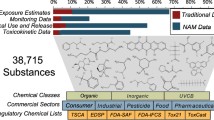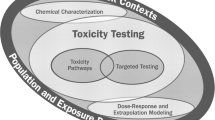Abstract
Among bioassays for evaluating various impacts of chemicalson humans and ecosystems, those based on culturedmammalian-cells can best predict acute lethal toxicity to humans. Weexpect them to be employed in the future in environmentalrisk management alongside mutagenicity tests and endocrine-disrupting activity tests. We recently developed adisposable bioassay device that immobilizes humanhepatocarcinoma cells in a small micropipette tip. Thisenables very quick (within 2 h) evaluation of acute lethaltoxicity to humans. For bioassay-based environmentalmanagement, 2 promising approaches have been demonstrated bythe US-EPA: toxicity identification evaluation (TIE) andtoxicity reduction evaluation (TRE). The Japanese Ministryof Environment has been supporting a multi-center validationproject, aimed at assembling a bioassay database. To makefull use of these resources, we present a numerical modelthat describes contribution of individual chemical toobserved toxicity. This will allow the selection of the mosteffective countermeasure to reduce the toxicity. Bioassay-based environmental risk management works retrospectively,whereas impact assessment using substance flow models andtoxicity databases works prospective. We expect that these 2approaches will exchange information, act complementarily,and work effectively in keeping our environment healthy inthe 21st century.
Similar content being viewed by others
References
Aden, D. P., Fogel, A., Plotkin, S., Damjanov, I. and Knowles, B.B.: 1979, ‘Controlled synthesis of HBsAg in a differentiated human liver carcinoma-derived cell line’, Nature 282, 615–616.
Baba, K. and Yahagi, H.: 1988, ‘Image auto-monitoring system of fish movement patterns for detecting acute toxicity in fresh water – Studies on image recognition’, Jpn. J. Water Pollution Res. 11, 114–122 (in Japanese).
Clemedson C. et al.: 1996, ‘MEIC evaluation of acute systemic toxicity, Part II. In vitro results from 68 toxicity assays used to test the first 30 reference chemicals and a comparative cytotoxicity analysis’, ATLA 24, 273–311.
Connolly, D. T., Knight, M. B., Harakas, N. K., Wittwer, A. J. and Feder, J.: 1986, ‘Determination of the number of endothelial cells in culture using an acid phosphatase assay’, Anal. Biochem. 152, 136–140.
Giaever, I. and Keese, C. R.: 1993, ‘A morphological biosensor for mammalian cells’, Nature 366, 591–592.
Goldstein, J. L. and Brown, M. S.: 1977, ‘Genetics of the LDLreceptor: evidence that the mutations affecting binding and internalization are allelic’, Cell 12, 629–641.
Gu, M. B., Mitchell, R. and Kim, J. H.: 2000, ‘Continuous monitoring of protein damaging toxicity using a recombinant bioluminescent Escherichia coli’, ACS Symp. Series 762, 185–196.
Guinee, J., Heijungs, R., Van Oers, L., Van de Meent, D., Vermeire, T. and Rikken, M.: 1997, ‘LCA impact assessment of toxic releases: Generic modeling of fate, exposure and effect for ecosystems and human beings with data for about 100 chemicals’, Dutch Ministry of Housing, Spatial Planning and Environment, Industry, Building, Manufacture and Consumers Directorate, The Hague, The Netherlands.
Paterson, S. M. and Stauber, J. L.: 1996, ‘New algal enzyme bioassay for the rapid assessment of aquatic toxicity’, Bull. Environ. Contamin. Toxicol. 56, 750–757.
Karube, M., Hiramoto, K., Kawarai, M. and Sode, K.: 1989, ‘Biosensors for toxic compound using immobilized animal cell membrane’, Membrane 14, 311–318.
Haas, C. N., Cidambi, K., Kersten, S. and Wright, K.: 1996, ‘Quantitative description of mixture toxicity: Effect of level of response on interaction’, Environ. Toxicol. Chem. 15, 1429–1437.
Shoji, R., Sakoda, A., Sakai, Y. and Suzuki, M.: 1998, ‘Rapid bioassay of toxicity in environmental water by LDL-uptaking activity of human cells’, Water. Sci. Technol. 38, 271–278.
Shoji, R., Sakai, Y., Sakoda, A. and Suzuki, M.: 2000a, ‘Development of a rapid and sensitive bioassay device using human cells immobilized in macroporous microcarriers for the on-site evaluation of environmental waters’, Appl. Microb. Biotechnol. 54, 432–438.
Shoji, R., Sakoda, A., Sakai, Y., Utsumi, H., and Suzuki, M.: 2000b, ‘Quantitative description of mixture toxicity of chemicals and environmental waters detected by bioassays’, J. Jpn. Soc.Water Environ. 23, 487–494 (in Japanese).
Stopeck, A. T., Nicholson, A. C., Mancini, F. P. and Hajjar, D. P.: 1993, ‘Cytokine regulation of low-density lipoprotein receptor gene transcription in Hep G2 cells’, J. Biol. Chem. 268, 17489–17494.
Tanaka, Y., Taguchi, K. Otoji, Y., Hoshikawa, H., Sasaki, H., Mitsumori, Y. Saito, Y. and Kashimura, O.: 1996, ‘Development of a continuous and automated acute toxicity monitoring system using a biosensor’, EICA 1, 250–253.
USEPA: 1988, ‘Methods for aquatic toxicity identification evaluations – Phase I Toxicity characterization procedures’, EPA/600/3/034, US Environmental Protection Agency, Duluth, MN, USA.
USEPA: 1989a, ‘Methods for aquatic toxicity identification evaluations – Phase II Toxicity characterization procedures’, EPA/600/3–88/035, US Environmental Protection Agency, Duluth, MN, USA.
USEPA: 1989b, ‘Methods for aquatic toxicity identification evaluations – Phase III Toxicity characterization procedures’, EPA/600/3–88/036, US Environmental Protection Agency, Duluth, MN, USA.
USEPA: 1989c, ‘Toxicity reduction evaluation protocol for municipal wastewater treatment plant’, EPA/600/2–88/062, US Environmental Protection Agency, Cincinnati, OH, USA.
USEPA: 1989d, ‘Generalized methodology for conducting industrial toxicity reduction evaluation (TREs)’, EPA/600/2–88/070, US Environmental Protection Agency, Cincinnati, OH, USA.
USEPA: 1994, ‘Interim guidance on determination and use of water-effect ratios for metals’, EPA/823/B/94/001, Final Report, US Environmental Protection Agency, Washington, DC, USA.
Utsumi, H., Nakasugi, O., Nishimura, T., Sakoda, A., Oguri, R. and Higuchi, R.: 1999, ‘Development of bioassays to evaluate human and ecological impacts of pollutants’, Proc. Asian Waterqual. '99 (7th IAWQ Asia-Pacific Regional Conference), Taipei, pp. 275–280.
Yasuhara, A., Shiraishi, H., Nishikawa, M., Yamamoto T., Nakasugi, O., Okumura, T., Kenmotsu, K., Fukui, H., Nagase, M. and Kawagoshi, Y.: 1999, ‘Organic components in leachates from hazardous waste disposal sites’, Waste Manage. Res. 17, 186–197.
Author information
Authors and Affiliations
Corresponding author
Rights and permissions
About this article
Cite this article
Sakai, Y., Shoji, R., Kim, BS. et al. Cultured Human-Cell-Based Bioassay for Environmental Risk Management. Environ Monit Assess 70, 57–70 (2001). https://doi.org/10.1023/A:1010692108932
Issue Date:
DOI: https://doi.org/10.1023/A:1010692108932




